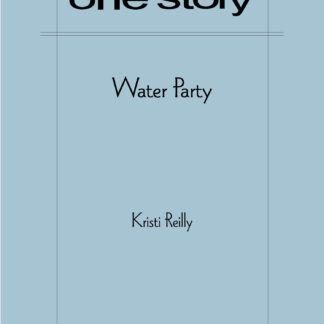
Water Party
$2.50
42 in stock
Excerpt
After the rainy season, the house went dry. A water pipe to our neighborhood failed. The faucets coughed and spat when turned. A white residue of soap ringed the drain in the patio where the housekeeper once scrubbed our clothes. Our laundry piled up, unwashed. Winchet, our landlady, who lived with her sister out by the old airport in Mekanisa, brought jerrycans and we tipped them into smaller buckets to bathe and flush the toilet.
We used the water too quickly.
“Winchet is going to kill us,” Esther said when she got to the last can.
“She might.” I was secretly afraid of Winchet.
We could have a party, Esther suggested. Instead of bottles of tej, the sweet honey wine, or beer, guests could fill up jerrycans with water and bring them to the house.
I thought of Winchet driving over in her little white Corolla, the hatchback sagging from the weight of cans in the back. Her face pinched with annoyance. A party would be better, I agreed.
Kristi Reilly
Kristi Reilly is a taxonomist for The New York Times. Her writing awards include first place in Seventeen magazine’s annual fiction contest and honorable mention in Glimmer Train. She is currently at work on a collection of short stories.
Q&A by Hannah Tinti
- HT: Where did the idea for this story come from?
- KR: I took a trip to Ethiopia back in 1999 to visit my sister when she was working for Save the Children. It was the most exotic, far-away place I’d ever been and I wanted to write a story set there. Since much of my time was spent in this expat world, I decided to start there. I heard about this biologist studying geladas up in the Simien mountains. People retold these crazy-but-true stories of what he endured living up in that very remote area. None of his tales actually ended up in the story, but they were what got me thinking, there must be a short story in all this.
- HT: What was the most challenging aspect of writing this story?
- KR: I was so intent on making a story about a biologist and these monkeys, I had to backfill Tess and her relationship with Theo after I started, which was difficult since technically they’re the more central thread. It was kind of backwards, working from the outside-in, from the monkeys to the humans. It probably wasn’t the most efficient way into the story.
- HT: How much do you know about geladas? Can you talk a bit about any research you might have done, and their role in the story?
- KR: It’s a very inexpert knowledge. I googled a lot and I watched a BBC series about them (based on the research of the same biologist). The series focused on this one alpha male and his harem—specifically the story of his downfall, how the females turn against him when he fails to protect one of the babies. But the alpha male’s problems actually begin with an injury to his hand, which prevents him from grooming the females. That’s the beginning of his downfall. I think of their role in the story as an example of connections built on proximity and physical contact.
- HT: There is a great line about Tess “inwardly titling, lacking my own center.” Do you think this feeds into her desire to be “seen?” Or does this have more to do with her age, or her situation as “the other woman”?
- KR: Yes, probably a bit of all those things. Being young and inexperienced in that situation probably plays into her insecurity and leads to her misunderstanding the kind of attention she’s getting from Theo. So I think it drives her to put on the dress of someone who she believes is more genuinely desired.
- HT: There’s a lot of talk about talking in this story—the geladas vs. the Harari. Who do you think communicates better?
- KR: The geladas are certainly impressive, they communicate in so many ways—vocalizations, grooming, lip smacking, touching noses. Harari culture is not something I can claim to know well, I do remember seeing the tiny room where newlyweds stayed and being impressed that two people could live there for an entire week, sort of a honeymoon-in-captivity.
- HT: What do you think happens next for Tess?
- KR: I think she mellows out a bit. Maybe she and Winchet become friends.
- HT: How long did it take you to complete this story?
- KR: I’ve been trying to write an Ethiopia story ever since I took the trip. I tried it from different points of view and characters, but I couldn’t get it to work. This version, the one that stuck, I wrote last summer, then I reworked it with Hannah over the course of a year, putting it down for several months at a time. My sister and my mother (who also came along for the trip) both helped with fact-checking/filling in the details with our collective memories of the trip.
- HT: What are you working on now?
- KR: More stories, for a collection.
- HT: What is the best bit of advice about writing you have ever received?
- KR: There’s an Amy Tan story where a character says, “You cannot be an artist if your work comes without effort. That is the problem with modern bottled ink. You do not have to think. You simply write what is swimming on the top of your brain, which is nothing but pond scum, dead leaves and mosquito spawn.” I’ve always thought it was a nice way of saying anything worthwhile comes out in revision. Or that’s been my experience. Much of what I write on the first draft makes me cringe. I think “pond scum/dead leaves/mosquito spawn,” and then I start rewriting.
